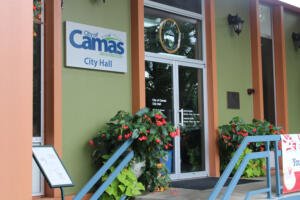In an effort to shore up a nearly $6 million budget shortfall, maintain the city’s streets and invest in the police department, the Camas City Council this week approved several revenue packages included in Camas Mayor Steve Hogan’s proposed 2025-26 budget.
The Council adopted an ordinance that will sunset the existing 2% tax on the City’s water, stormwater, sewer and solid waste (garbage) utilities on Dec. 31, and begin a new 2% utility tax the following day, on Jan. 1, 2025. The ordinance includes a mandatory review of the tax during the City’s biennial budget process and also allows the City to waive or decrease the utility tax for low-income residents.
“We are talking about re-adopting the 2% utility tax to fund core services such as the municipal court, the fire department, the library, parks and recreation (and) streets maintenance,” Camas Finance Director Cathy Huber Nickerson told Council members during their regular meeting on Monday, Nov. 18.
Huber Nickerson added that the 2% utility tax — originally approved by the Council in 2022 to bridge a funding gap in the City’s general fund until Camas and Washougal could find a better solution for funding the cities’ joint fire department and help diversify the City’s revenues by creating what Huber Nickerson has called a “three-legged stool” of property, sales and utility tax revenue sources — was part of Hogan’s plan to close a $5.8 million revenue gap in the 2025-26 budget and maintain the City’s current levels of service.
The City had faced an $8.7 million structural deficit, thanks to expenses that increased by $12.9 million between 2021 and 2025 — mainly due to increases in salaries and benefits, new staffing positions and contributions to the fire and streets departments — but cut that deficit by nearly $3 million after reducing its baseline costs by $200,000, saving $2.4 million by not filling 16 positions approved in the 2023-24 budget and reorganizing its information technology (IT) and facilities departments to save an additional $316,000.





